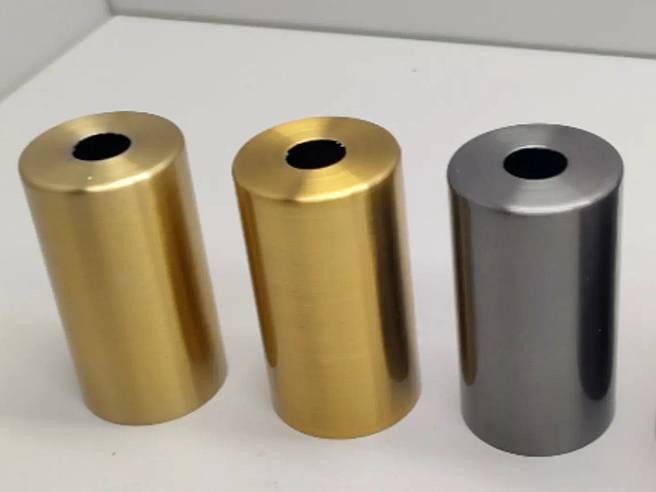Alodine Coating: Corrosion Protection for Aerospace and Defense Parts
Introduction
Alodine coating, also known as chemical conversion coating or chromate conversion coating, is a crucial surface treatment providing superior corrosion protection and enhanced adhesion properties for 3D printed parts, especially in aerospace and defense applications. This chemical process involves applying a thin chromate conversion layer onto metal surfaces, predominantly aluminum alloys, to significantly improve corrosion resistance and prepare surfaces for subsequent painting or bonding operations. Applying Alodine coatings is governed by stringent international standards, such as MIL-DTL-5541 and ASTM B449, ensuring consistent quality and reliability in demanding operational environments.
This blog will explore the Alodine coating process, its key advantages for 3D printed components, suitable materials, and prominent industry applications. Additionally, we will compare Alodine coatings to other relevant surface treatments, providing essential insights to optimize your selection process for critical aerospace and defense parts.
How Alodine Coating Works and Quality Assessment Criteria
The Alodine coating process involves chemically reacting the metal substrate with a chromate-containing solution, forming a thin, protective, corrosion-resistant layer. This conversion coating is typically transparent, golden, or slightly iridescent and ensures excellent paint adhesion, reduced electrical resistance, and superior corrosion resistance.
Key Quality Assessment Criteria:
Corrosion Resistance: Evaluated using standardized salt spray tests per ASTM B117, Alodine coatings typically demonstrate corrosion resistance exceeding 168 hours without significant corrosion or coating deterioration.
Coating Thickness: Typically ranges from 0.2 to 1.0 microns, measured via precise thickness gauges or eddy current methods, ensuring minimal dimensional impact.
Electrical Conductivity: Assessed according to MIL-DTL-5541, Class 3 coatings retain good electrical conductivity essential for electromagnetic interference (EMI) shielding and electrical grounding applications.
Adhesion Strength: Verified using standard adhesion tests such as ASTM D3359, confirming excellent bonding properties to paints and adhesives, critical for aerospace and defense standards.
Alodine Coating Process Flow and Key Parameter Control
The Alodine process includes tightly controlled steps:
Surface Preparation: Parts undergo thorough cleaning (alkaline degreasing or acid etching) to remove contaminants and achieve a suitable surface roughness (Ra 0.2–1.0 µm).
Application of Alodine Solution: Parts are immersed, sprayed, or brushed with the chromate conversion solution at controlled temperatures (typically 20°C–30°C) for durations of 1–5 minutes.
Rinsing: Thorough rinsing with deionized water removes residual chemicals, ensuring a clean, uniform conversion coating.
Drying: Parts are carefully dried using forced-air ovens at temperatures around 50°C–60°C, minimizing residual moisture.
Quality Inspection: Final inspection for uniformity, coating thickness, corrosion resistance (salt spray tests), and conductivity compliance ensures adherence to international standards.
Applicable Materials and Scenarios
Alodine coatings are primarily applied to aluminum-based 3D printed alloys due to their inherent susceptibility to corrosion. Below are common 3D printed materials suitable for Alodine coating, with their primary aerospace and defense applications:
Material | Common Alloys | Applications | Industries |
|---|---|---|---|
Structural components, avionics housings, radar enclosures | Aerospace, Defense | ||
A20X (Aluminum-Cu-Mg) | Lightweight aerospace structures, drone components | Aerospace, Defense | |
Ti-6Al-4V (limited use for specialized applications) | Aerospace fittings, brackets requiring surface preparation | Aerospace, Defense |
Alodine coatings excel in applications requiring exceptional corrosion resistance, paint adhesion, and electrical conductivity, critical in aerospace and defense components exposed to severe environmental conditions.
Advantages and Limitations of Alodine Coating for 3D Printed Parts
Advantages:
Excellent Corrosion Resistance: Provides robust protection against corrosion, ensuring reliability and longevity in harsh aerospace and defense environments.
Enhanced Paint Adhesion: Significantly improves bonding for paints and adhesives, meeting aerospace quality requirements.
Electrical Conductivity: Maintains sufficient electrical conductivity for EMI shielding and grounding purposes (Class 3 coatings).
Minimal Dimensional Impact: Extremely thin coatings ensure no significant effect on part dimensions, ideal for precision components.
Limitations:
Limited Material Compatibility: Primarily suitable for aluminum alloys; effectiveness on titanium or magnesium alloys requires special procedures or alternative treatments.
Environmental Concerns: Traditional chromate-based solutions contain hexavalent chromium, raising environmental and safety considerations, although chromium-free alternatives are increasingly available.
Process Control Sensitivity: Requires strict control of solution concentration, temperature, and immersion time to maintain coating quality, adherence to standards, and repeatability.
Alodine Coating vs. Other Surface Treatment Processes
Below is a comparative analysis of Alodine coating with other common surface treatments for 3D printed aerospace and defense parts:
Surface Treatment | Description | Corrosion Resistance | Electrical Conductivity | Thickness | Typical Applications |
|---|---|---|---|---|---|
Chromate conversion coating | Excellent (168+ hrs salt spray) | High (Class 3) | 0.2–1.0 µm | Aerospace, Defense | |
Electrochemical oxide coating | Excellent (336+ hrs salt spray) | Poor (insulative) | 10–25 µm | Aerospace, Automotive | |
Metallic deposition process | Good to Excellent | Good to High (depending on metal) | 5–20 µm | Defense, Electronics | |
Electrostatic powder coating | Excellent | Poor (insulative) | 50–150 µm | Automotive, Defense |
Application Cases for Alodine Coated 3D Printed Parts
Alodine coatings significantly enhance performance and reliability across critical aerospace and defense applications:
Aerospace Structural Components: Alodine-coated aluminum structural brackets and fittings demonstrate enhanced corrosion resistance (ASTM B117 salt spray test >168 hours), significantly extending part service life.
Defense Avionics and Radar Enclosures: Alodine-coated housings improve electrical conductivity and EMI shielding, essential for sensitive electronics in harsh operational environments.
UAV and Drone Components: Alodine-treated aluminum and magnesium components reduce corrosion risks and improve paint adhesion, ensuring reliability under environmental stress conditions.
Military Vehicle Parts: Alodine coating on aluminum structural and protective parts provides effective corrosion protection and enhanced paint bonding, significantly improving component durability.
FAQs
What is Alodine coating, and how does it protect aerospace components?
Which 3D printed materials are best suited for Alodine treatment?
How does Alodine coating compare to anodizing for corrosion protection?
What aerospace and defense standards apply to Alodine coatings?
Are there environmentally friendly alternatives to traditional Alodine coatings?

